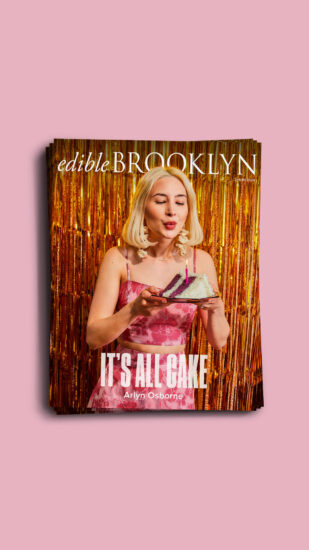 “It’s my personal theory that their rotting flesh attracted dinosaurs and caused ginkgo seeds to be dispersed everywhere,” muses Matt Weingarten, Fort Greene resident and chef of Manhattan’s Inside Park in St. Bartholomew Church on Park and 51st.
“It’s my personal theory that their rotting flesh attracted dinosaurs and caused ginkgo seeds to be dispersed everywhere,” muses Matt Weingarten, Fort Greene resident and chef of Manhattan’s Inside Park in St. Bartholomew Church on Park and 51st.
Tall with a torrent of auburn hair and thick-framed glasses, Matt has a penchant for foraging wild urban edibles, and the stinky fruit of the ginkgo tree, which he gathers each fall in Fort Greene Park, is one of his favorites. Prior to joining Inside Park he was sous chef at SoHo’s ingredient temple, Savoy, where he and chef Peter Hoffman dreamt up dishes like roasted ginkgo nuts with chicory, radicchio and pickled mackerel.
Ginkgo trees, tall with long branches that stretch up as if attempting to pierce a cloud, are survivors: the species dates back hundreds of millions of years and the modern incarnation is remarkably resilient to pollution, pestilence, acid rain and being backed into by delivery trucks and unskilled parallel parkers.
For many city dwellers, the overly unctuous, even putrid stench of ginkgos is as much a harbinger of fall as is the dependable return of tall boots and houndstooth. While both male and female trees sport the telltale delicate fanned leaves, only females produce the infamously foul-fragranced fall fruit. But while some New Yorkers find the odor of the trees’ droppings unbearable (the Urban Forestry Administration spritzes ginkgos with a pesticide perfume of sorts for property owners concerned about the offensive odor), others love to devour the annual fruit-fall, and anyone brave enough to peel away the mushy, odiferous outer layer is rewarded with a small nut that is quite palatable, with flavors of mushrooms, chestnuts and earth.
Matt was introduced to the world of odd edibles at age seven when IBM transferred his father to England, and their new house came with a gardener.
“He didn’t like me because I climbed the fruit trees. We had all kinds of cool stuff I’d never heard of before, like damson plums and purple broccoli. It’s funny—I can’t remember anything about the house, but I remember everything about that garden.”
While studying at the University of Ohio, he cultivated his own garden and stocked it with unusual botanicals like borage and hyssop. After college, Matt taught English in Taiwan. He hated the job but loved the food and resolved to pursue a career behind the stove. He moved to New York, enrolled at Peter Kump’s Cooking School (now the Institute of Culinary Education) and, after stints at Porcupine and Savoy, signed on with food giant Sodexo to elevate the restaurant and café formerly known as St. Bart’s, now rechristened Inside Park.
Today, gardenless but resourceful, he strolls the streets of Fort Greene and Clinton Hill, sometimes with his two-year-old daughter, on the lookout for local botanicals. Recent urban finds include Fort Greene Park’s Osage oranges (neither citrus nor edible, but prized as a natural cockroach deterrent), rose hips for marmalade snapped from bushes in front of Clinton Avenue’s “Kansas house” (because it looks like a house you’d see in Kansas, he says), chamomile from the sidewalk cracks that vein Washington Avenue, Atlantic Avenue’s wild quince, wild blackberries from a vine that grows helter-skelter across a carriage house on Waverly, white mulberries from a nearby university campus and a single lonely Golden Delicious apple tree on Willoughby, from which he swats down the occasional apple to snack on while walking to the subway.
One autumn afternoon Matt was inspired by a crowd of Chinese women he noticed hunched beneath a canopy of intensely yellow ginkgo leaves, gathering the fetid fruits. No, they weren’t planning feasts for extended families nor stockpiling for the upcoming winter—the women, spotted each fall on sidewalks citywide, are entrepreneurs who sell the gleaned nuts in Chinatown, where shoppers tuck them into everything from steamed egg custards to potions for tinnitus. (In addition to their culinary qualities, the fruit and nut have been treasured for millennia in Asian medicine, and reportedly help suffers of ailments from asthma to Alzheimer’s.)
Matt’s first ginkgo-foraging foray yielded heavy, heady results: two plastic bags bulging with malodorous fruit. Unfortunately he didn’t yet know that one would do well to shell the ginkgo before bringing it—and its aroma—indoors. He has since learned his lesson and, by observing expert Chinese matriarchs, knows to pop off the flesh and take only the benign nut. (His wife, Katka, finds this a great improvement.) The harvest has since become a fall tradition for him—and for his restaurant patrons.
Do they know that their ginkgo is coming from the ground of a city park abutting a housing project?
“I always educate our servers on the provenance of ingredients,” laughs Matt. “I’m sure many of them used this aspect of the story to sell the dish.”
Roasted Ginkgo Nuts
After collecting the ginkgo nuts, discard the smelly, fleshy outer layer. Thoroughly wash the nuts in cold water, dry completely, place on a rimmed baking sheet and roast in a 300-degree oven for 20 minutes. Remove from the oven and, while still hot, gently tap each with a hammer or the bottom of a heavy skillet. The thin shell will crack, revealing the sweet green nut inside.
Use roasted ginkgos as you would toasted almonds or peanuts—in salads, pilafs or finely ground for use in pie pastry or in traditional Chinese egg custard.
Former Cook’s Illustrated editor Raquel Pelzel freelances for the Wall Street Journal and Saveur (among others) and writes cookbooks from her home in Clinton Hill. At present she’s working on a book about urban gardening and cooking tentatively titled City Dirt.



